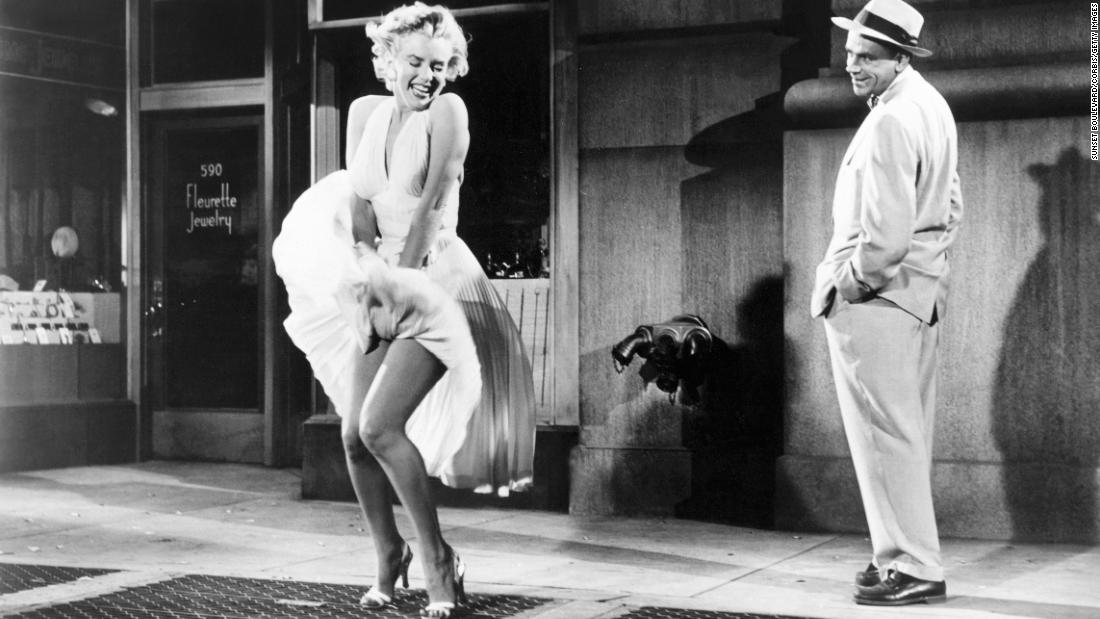Marilyn Monroe's dress was auctioned for 4.8 million dollars 1:12
(CNN) --
Marilyn Monroe is one of the best-known celebrities of all time.
As a household name whose work has been mentioned in everything from "Moulin Rouge" to "Ru Paul's Drag Race," the Golden Age actress managed to make a widespread impact during her short career.
With so much notoriety comes a tendency to create myths.
Monroe's personality has morphed into a larger-than-life caricature, her most iconic outfits have come to define her entire image, but in many ways her legacy has been misunderstood.
Here are 10 misconceptions about Marilyn Monroe.
1. Her name was Marilyn Monroe
Although it is the name by which she is best known, the name Marilyn Monroe was not the first name used by California native Norma Jeane Mortenson.
After her birth, she was baptized with her mother's name: Norma Jeane Baker.
She carried that name with her through foster care until she married a neighbor at age 16 and became Norma Jeane Dougherty.
It wasn't until he signed his first acting contract with 20th Century Fox that he began to contemplate the perfect stage name.
Monroe and studio executive Ben Lyon teamed up to come up with the nickname that would help catapult her to stardom.
Lyon suggested Marilyn after actress Marilyn Miller and Norma Jeane suggested Monroe after her mother's family.
advertising
Thus the name of Marilyn Monroe was born;
his iconic look and personality would soon follow.
2. She was naturally blonde
Monroe's iconic platinum blonde locks weren't born with her, like many other stars at the time.
For women hoping to make a name for themselves in the film industry in the 1940s, blonde was considered the most versatile hair color. Monroe, who joined her first modeling agency as a curly-haired brunette, dedicated herself to doing whatever it took to turn heads. He started lightening his hair in the mid-1940s and was instantly hooked.
"For Marilyn, going blonde was like the Hollywood star building machine," said photographer Nancy Lee Andrews, "she saw what it could do for her."
Over the years, Marilyn continued to lighten her hair until it finally reached her iconic platinum blonde shade, or as she called it, "pillowcase white."
The color is still associated with her to this day, referenced everywhere from magazines to Billie Eilish's Met Gala appearance.
3. She was discovered while babysitting
With a name secured and a new hairstyle, the next step for the up-and-coming star was to craft a good origin story.
20th Century Fox publicists introduced Monroe to the press as a young orphan who was discovered while working for a Fox talent scout.
In reality, Monroe fought for her opportunities and was eager to learn the ins and outs of the film industry.
As Sarah Churchwell, author of "The Many Lives of Marilyn Monroe," puts it, "Marilyn wasn't waiting for powerful men to come looking for her. She was knocking on the studio door. She was doing absolutely everything she could to break the movie business." .
4. He gained fame easily
Stardom didn't just fall into Marilyn Monroe's lap.
Beauty and talent were considered basic necessities for any woman aspiring to work in the male-dominated film industry, and actors needed a contract with the "Big Five" (Warner Brothers, RKO, MGM, Paramount, or 20th Century Fox) to succeed.
Monroe struggled to get a long-term contract.
He landed small roles with 20th Century Fox and Columbia Pictures before finally landing a seven-year contract with Fox in 1951. What he lacked in immediate success on screen, however, he made up for with a tenacious understanding of his off-screen audience. the screen.
Monroe was able to use press coverage, like taking advantage of her relationship with Joe DiMaggio, to keep her name relevant.
As Alicia Malone of Turner Classic Movies explains, Marilyn was "very, very savvy with publicity and very funny. Marilyn always seemed to know what the advertisers wanted, what the photographers wanted. So whenever an opportunity presented itself, I made the most of that."
5. He had no control over his sexuality
Sex sells, and if anyone knew this, it was Monroe.
While she was frustrated with the tendency of film and print executives to reduce her to a sex symbol and nothing more, Monroe understood the power her unique sexuality could give her.
Time and time again, she was pigeonholed into roles meant to look good on screen and little else, but she wouldn't let the transaction go one way.
"She manages to be sexually attractive and the object of the male gaze in all the ways she needs to be," says Sarah Churchwell of Monroe's first performance in "Ladies of the Chorus," "but she also makes fun of that." .
And that's the moment Marilyn figured out how this performance was going to work for her."
Monroe not only leaned into her status as a sex bomb, she also refused to be ashamed of it.
Early in her career, Monroe posed nude for a photographer when she had no money.
Rather than capitulate to popular conservatism at the time the photo shoot was exposed in the press, Marilyn stood by her decision.
"They said, 'Did you pose for a calendar?'" Monroe recalled, "and I said, 'Yeah, did something happen?'"
6. He never spoke out against sexism in Hollywood
The studio system of the 1940s and 1950s treated women as commodities;
sex and relationships were exchanged and often expected in return for auditions and contracts.
Monroe was not exempt from participating and received many unwanted advances while working towards a career in acting. At Columbia Pictures, studio head Harry Cohn invited Monroe on a trip on his yacht. Monroe suggested that she would only attend if Cohn's wife was also invited. Shortly after her rejection, she was terminated from her contract.
Decades before the Times Up movement, Monroe detailed the bullying she faced in an article titled "Wolves I've Known" published in "Motion Picture and Television Magazine."
She wrote, "there are many kinds of wolves. Some are sinister, some are just funny Charlies trying to get something for nothing, and some make a game out of it."
She called out the powerful men she had come up against as a hopeful and shed light on the unsafe conditions women were forced to endure if they wanted a career in film.
7. She was not a serious actress
Monroe is known for her iconic roles in which she played ditzy blondes, but behind the scenes she was anything but dumb. Early in her career, she sought guidance from Natasha Lytess, a theater director for Columbia Pictures. According to "Marilyn Monroe: The Personal Archive" author Cindy de la Hoz, Lytess brought a "wealth of theater knowledge [that] was very appealing to Marilyn. She wanted to get this kind of serious acting education."
Even after achieving great success in her career, Monroe continued to look for opportunities to become a more serious actress.
She enrolled in classes with Lee Strasberg at the Actors Studio in New York, where her classmates despised the flashy careers of movie stars like her.
But Monroe was a student dedicated to method acting and earned the respect of her classmates with her hard work.
Actress Ellen Burstyn witnessed Anna Christie's portrayal of Marilyn in the studio.
"Everyone who saw that says that it was not only the best work Marilyn ever did, but it was some of the best work ever seen at Studio," he recalled.
"She achieved real greatness in that scene."
8. She was not politically active
Marilyn Monroe had strong political convictions.
After her marriage to Joe DiMaggio in 1954, Marilyn took a detour from her honeymoon in Japan to tour US military bases in Korea.
He performed for approximately 100,000 servicemen over the course of ten shows.
Monroe also supported her friends at home.
She was very close to singer Ella Fitzgerald and a huge supporter of her career.
When the popular Mocambo nightclub refused to book Fitzgerald, Monroe called the club and proposed that if they booked Fitzgerald for a week, she would sit in the front row for every performance.
After the club agreed, Fitzgerald sold out and was subsequently booked for a second week.
The success took her career to a whole new level.
In a 1972 interview with Ms. magazine, Fitzgerald recalled her relationship with Monroe, saying, "I owe a real debt to Marilyn Monroe...she was an unusual woman, a little ahead of her time. And she didn't know it."
9. They paid him like a big star
Although she was one of the most talked about actresses of the time, Marilyn's star power didn't always result in a hefty paycheck.
At the end of his career, he was earning a fraction of the money his contemporaries were earning.
On the last film she worked on, "Something's Gotta Give," Monroe was set to earn $100,000, far less than the million dollars Elizabeth Taylor was reported to be earning for "Cleopatra" around the same time.
The pay disparity was even worse early in his career, but Monroe put up a fight.
In 1954, Monroe was ready to start work on the movie "The Girl in Pink Tights" when she learned that her co-star, Frank Sinatra, would be earning more than three times her weekly salary.
In protest, Marilyn refused to show up on set, forcing the film to be delayed and eventually halt production altogether.
"For anyone who thinks Monroe was a perpetual victim, she walked off the set of 'Pink Tights,'" noted film critic Molly Haskell.
"All said."
10. It did not impact the industry
Although she loved acting, Monroe was unhappy with the roles she was offered at 20th Century Fox. She longed to add more diversity and depth to her characters.
After filming "The Seven Year Itch" wrapped, Monroe broke her contract and fled Los Angeles.
Despite threatening phone calls from Fox's legal teams and studio head Daryl Zanuck, Monroe began a new life in New York City.
She and her friend, photographer Milton Greene, created Marilyn Monroe Productions, making her the first woman since Mary Pickford to start her own production company.
Fox tried to diminish Monroe's achievements by proposing that they could find a dozen actresses like her, but Marilyn's brand only grew. She couldn't be replaced. At the end of 1955, Fox gave up and Monroe received a new historic contract. Not only was his salary increased, but he was also given story approval, director approval, and cinematographer approval, an achievement "said by veterans of the film scene...was one of the greatest ever." individual triumphs ever achieved by an actress," reported "Los Angeles Mirror".
The studio system that dictated much of Monroe's career was beginning to crack.
Although she was not around to experience the development of the industry in the 1960s and beyond, the effects of her efforts can still be seen today.
Hollywood Marilyn Monroe


/cloudfront-eu-central-1.images.arcpublishing.com/prisa/3J6DCILJR5DX5LBCZFVPLETXL4.jpg)



/cloudfront-eu-central-1.images.arcpublishing.com/prisa/JM6IZGTVEFFQZMHAFVDKPJ7CKM.jpg)


/cloudfront-eu-central-1.images.arcpublishing.com/prisa/U5K6GQUZTZACJAGDURPGR6UIOU.jpg)





